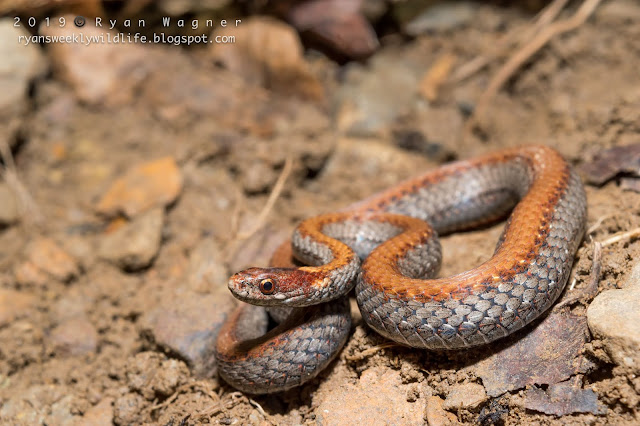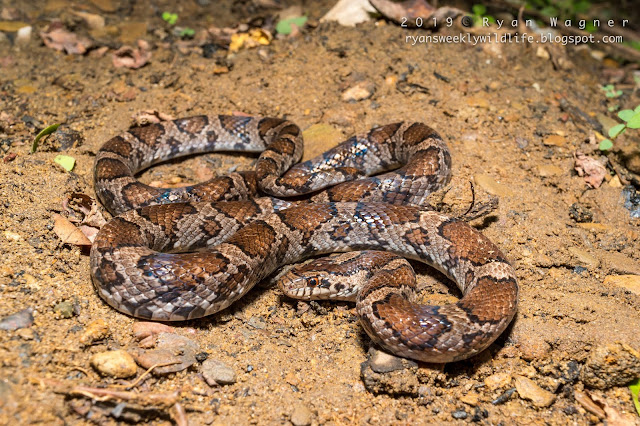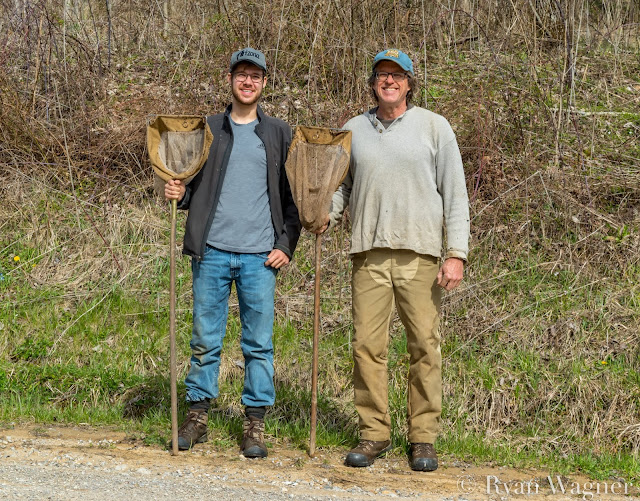“Also, there were many objects to overturn, and there was always the chance of finding something unusual beneath any log or rock. Springs and both clear and muddy streams abounded. In short, there was a great variety of habitats to be explored. The net result was that we probably spent more man hours in the hill country than in any other part of the state. Southeastern Ohio was unquestionably our favorite collecting area.”
—Roger Conant
Herpetology in Ohio—50 Years Ago
 |
| Northern Red-bellied Snake. |
As we pulled to a stop along the roadside, the fluttering hum of cicadas died down and the air hung still for a moment as if the forest was waiting to inhale. I grabbed my snake stick from the bed of the truck as Carl slipped his backpack over his head. We both knew the drill. The hillsides all around us held promise of snakes, lizards, and turtles hidden below cover.
During each of our treks into Ohio’s backwoods, I can’t help but feel we are a small instance of history repeating itself. Just shy of a century ago, Roger Conant might have hiked these very same hillsides and ravines. In the 1930s, Conant was the first to attempt an exhaustive survey of Ohio’s reptile diversity (an undertaking sorely in need of updating since the previous survey by Kirtland in 1838). During his six years as Curator of Reptiles at the Toledo Zoo, he would eventually make it to 87 of Ohio’s 88 counties, drive some 41,000 miles, collect countless voucher specimens, and publish his collective work in The Reptiles of Ohio in 1938.
 |
| Eastern Black Kingsnake. |
Like us, weekends were Conant’s designated field days. He would travel from his home base in Toledo, accompanied by a small and variable band of zoo colleagues, local naturalists, and a few wide-eyed teenagers, all eager to indulge their persistent childhood urges to catch the scaly and slimy. The crew would pack snake bags and collecting jars into Roger’s 1931 Chevy and set out for the unknown. Their findings were quintessential, helping to verify species records and contributing to the state’s first range maps.
Conant’s work wasn't limited to Ohio alone. Take down your copy of A Field Guide to Reptiles and Amphibians of Eastern and Central North America and you’ll find a conspicuous authorship. For most of us fascinated with reptiles and amphibians (Carl and myself included), this field guide was our ticket into the world of herpetology. Anyone who herps Ohio today (or anywhere in North America) is indebted to the work of Conant and his colleagues.
 |
| Eastern Smooth Earthsnake. |
For over 15 years, Carl Brune has spent his free weekends and rainy evenings ‘filling in Conant’s gaps.’ Originally from California, Carl moved to Ohio to teach physics at Ohio University. He has helped to expand the known ranges of species from copperheads to streamside salamanders, and has even authored two chapters in the Amphibians of Ohio Textbook.
 |
| Northern Copperhead. |
I began herping with him in late August 2017. Growing up in a suburb of Cleveland, reptile diversity was somewhat lacking. For as long as I can remember, I’ve dreamed of seeing the creatures hidden among the rolling hills of Ohio’s southern counties. In 2016, I moved to Athens to study Wildlife Biology and Conservation. By luck or fate, I found myself in the middle of one of Ohio’s most herpetologically diverse regions.
 |
| A map of the physiogeographic regions of Ohio from Conant's The Reptiles of Ohio. |
 |
| Black Racer. |
 |
| Northern Ring-necked Snake. |
Despite the disappearance of many of Ohio’s native fauna during this era of rapid and intense deforestation, there have been no documented extinctions for any of Ohio’s 47 species of reptile or 40 species of amphibian. Just how and where these fragile creatures survived is something of a mystery. Logging took place over many decades, and it is possible species found refuge in small, remaining tracts of habitat, recolonizing the surrounding land once the forest had regrown. Considering the scale of habitat loss that swept through Ohio in the 1800s, it is remarkable any native herpetofauna survived at all.
 |
| Black Ratsnake. |
Logs and rocks provide cool, moist places for snakes to hide during the heat of the day. Nature, however, can be supplemented with a little human ingenuity. In Conant’s time, logging operations left behind huge saw dust piles strewn along the steep slopes. When covered with pieces of hacked-off bark, these damp, sturdy piles provided the perfect escape from the elements. Conant recounts one exceptionally good find, “a large slab-covered pile in Hocking County yielded a fence lizard, three young broad head skinks, a northern water snake, eleven hatchling black rat snakes, and two juvenile copperheads.” As mill practices shifted, Conant’s fruitful saw dust piles became a thing of the past.
 |
| Eastern Milksnake. |
During the course of our search, Carl and I might flip upwards of 100 pieces of cover and hike ten miles through the ravines and hilltops, all to find a handful of serpents. Somedays, the snakes are plentiful, others require hours of work to find the most common of species. There is really no telling where or when a species might turn up; it's often a matter of being in the right place at the right time.
 |
| Eastern Wormsnake. |
Carl and I have been lucky enough to find more snakes in Ohio than most people will see in their entire lives. Even where snake populations appear stable, however, the impacts of humans are plainly visible. Whether it be road mortality, habitat loss, or direct persecution, "snakes engender mighty little sympathy from the general public," a statement that still rings true today.
Conant was well aware that with each decade, more species were pushed closer toward extirpation. Fifty years after his surveys, Conant lamented that, “many places that once supported thriving colonies of various species have vanished.” Rattlesnakes, spotted turtles, Kirtland’s snakes—species Conant would have commonly encountered in his day—have all but disappeared from most of the state.
Conant was well aware that with each decade, more species were pushed closer toward extirpation. Fifty years after his surveys, Conant lamented that, “many places that once supported thriving colonies of various species have vanished.” Rattlesnakes, spotted turtles, Kirtland’s snakes—species Conant would have commonly encountered in his day—have all but disappeared from most of the state.
 |
| Timber Rattlesnake. |
Conant laid the ground work for our modern generation of herpetologists. It is now up to us to protect the species and populations that remain. Efforts to mitigate the damage we have done to our natural environment can often seem confusing and convoluted, but I have found there is something very down to earth about the study of reptiles and amphibians. Even someone unaccustomed to the complex and long-winded jargon of scientific literature might be able to detect a hint of the adventure and mystery only thinly veiled behind tables of snout-vent lengths and scale counts.
Hobby, obsession, the ‘weird’ cousin of birding, call it what you will, but herping has captivated my life ever since I first opened Roger Conant's field guide. In a few months time, the snakes, lizards, and turtles will begin to emerge from their frozen retreats. Carl and I will soon be back among the rolling hills of Southern Ohio, flipping logs, boards, and carpets for the secrets hidden beneath. Only time will tell what we find.
Hobby, obsession, the ‘weird’ cousin of birding, call it what you will, but herping has captivated my life ever since I first opened Roger Conant's field guide. In a few months time, the snakes, lizards, and turtles will begin to emerge from their frozen retreats. Carl and I will soon be back among the rolling hills of Southern Ohio, flipping logs, boards, and carpets for the secrets hidden beneath. Only time will tell what we find.
 |
| Carl and myself after a day of dip netting for salamanders in 2018. |
Ryan Wagner is a student studying Wildlife Biology and Conservation at Ohio University. He is an avid herper, birder, nature blogger, and wildlife photographer. You can read more of his articles at ryansweeklywildlife.blogspot.com or follow him on twitter @weeklywildlife. You can read the guest post version of this blog at Jim McCormac's Birds and Biodiversity Blog.





I am glad to find your blog as introduced on Jim McCormack's blog. I know I will like to follow along even though I live in SW Indiana. We probably have many of the same creatures.
ReplyDeleteI'm so glad to hear you enjoyed my work! Indiana and Ohio definitely share a lot of species so hopefully some of my articles will pertain to you.
DeleteThanks to Jim McCormac, I learned of your Blog and checked it out, along with some of your past posts (nice labelling!). There's a LOT of really nice, informative info here! Keep it up. I will continue to watch...
ReplyDeleteThanks Ron!
DeleteWell done young man (I hope that you don't take that as a condescending insult -- I've been a field naturalist for over 50 years, so most people are young to me) -- keep exploring and keep writing.
ReplyDeleteThanks so much Woody!
Delete